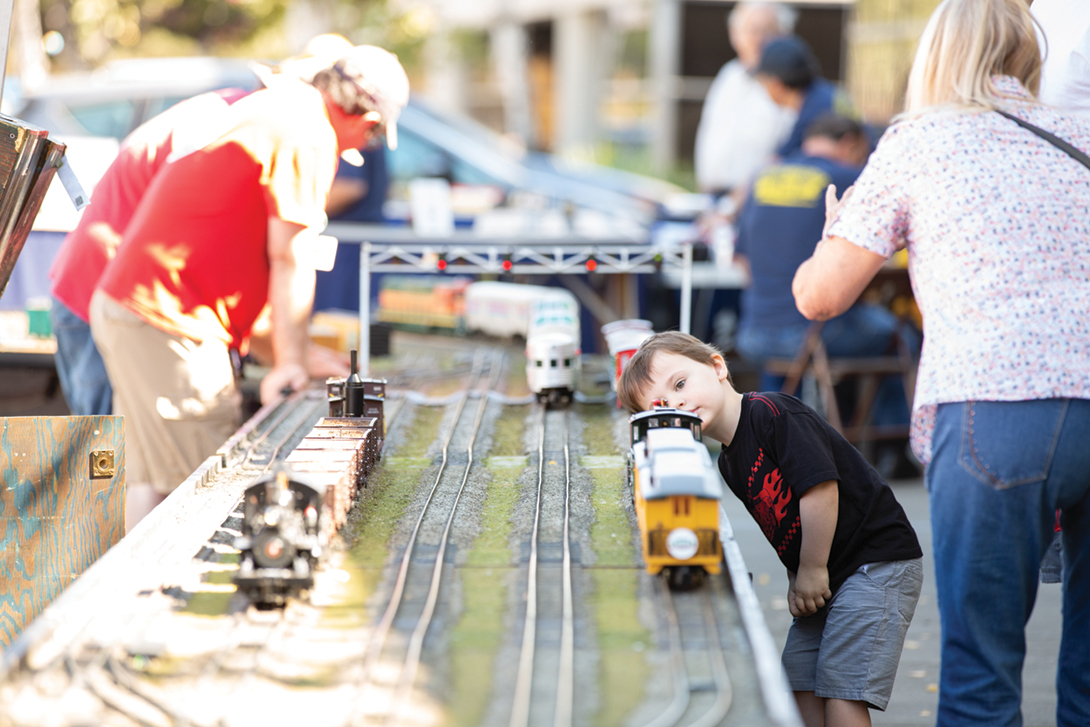WHILE THE SCOPE of model railroading in American culture has changed, people building their own train sets are as passionate as ever. In the mid 20th century, miniature trains circled family Christmas trees, and detailed miniature railroads ran in basements and attics across the country. In 2019, model trains have become decidedly niche; the once kid-centric hobby is now more popular with the older set.
Yet while young people today go for the fast feedback of mobile devices and video games, serious model railroad buffs share their enthusiasm with anyone interested, no matter their age. “Model railroading will never be as big as it was when I was young, but the community that’s here is vibrant,” Brian Hitchcock of European Train Enthusiasts’ Bay Area chapter says.
Who are they?
The majority of model railroaders are retired men with enough money and space to support their sprawling layouts. Many train enthusiasts enjoy showing others their constructions, but Richard Schoenstein of Santa Rosa prefers to keep his to himself. It’s a massive display that dominates the floor space of a warehouse on his property, and it’s mostly composed of O-scale trains running on three-rail tracks (the most common size for toy trains before the 1960s), which allow complex design. The landscapes are just as dazzling as the trains, with tiny buildings, carnivals, and baseball parks populated by countless little plastic people. At the flick of a switch, the scene springs to life, with lights, moving parts and sound effects. “It reminds me of when I was a little boy,” Schoenstein says of his setup, portions of it inspired by his hometown of Richmond.
Father-son partners Jerry and Matt Abreu, meanwhile, run the open-to-the-public Wandering Railroad, a stunning system of sleek O-scale trains winding in and out of a hilly, picturesque scene, all built into a mobile trailer for easy transport. The Abreus hope to take Wandering Railroad to children’s hospitals, veterans’ homes and train shows around the Bay Area and beyond. “When Matt was 10 or 11, we were living in Marin County and went to a train show,” Jerry recalls. “He got wide-eyed and excited about trains, and now, here we are.”
Where are they found?
With model railroading’s popularity on the wane, hobby shops have struggled, but the subculture thrives in Bay Area shops like Marin Hobby & Gift in San Anselmo and Just Trains in Concord and groups like the Carquinez Model Railroad Society and the Bay Area Model Railway Society.
When do they meet up?
Large model train shows are held regionally about four times a year. The Great Train Show is coming to Cal Expo in Sacramento in January; closer to home, the Golden State Model Railroad Museum in Point Richmond draws Bay Area enthusiasts with its 10,000-square-foot space chock-full of layouts. Just Trains in Concord also hosts train shows periodically.
What do they do?
Model railroading is a multifaceted craft that, apart from the beautiful trains themselves, involves woodworking, electrical engineering and miniature landscape design. Hunting down rare model trains (which can sometimes cost thousands of dollars apiece) is part of the hobby, but most enthusiasts also cherish the long, complicated, ultimately rewarding work of building the railroads and scenes.
Why do they do it?
Howard Hansen, resident model railroad expert of the recently closed Dollhouses, Trains and More in Novato, has loved trains for as long as he can remember, and he values the hobby for its hands-on aspect. “There are a lot of challenges to model railroading,” he says. “But it’s very fulfilling. It’s not for people who want instant gratification.”
Model Train Scales
Model trains come in a variety of lettered scales, each indicating the relative proportion to life-size trains. Z-scale trains are tiny and toy-size, while G-scale trains are hulking versions built for garden layouts. Here’s how the ratios of model to real life break down:
Z – 1:220
N – 1:160
HO – 1:87
S – 1:64
O – 1:48
G – 1:25
Photos by Bill Reitzel.

Bernard Boo is an AAPI arts and entertainment critic, Bay Area native and proud member of the San Francisco Bay Area Film Critics Circle. Find more of his work at PopMatters, Den of Geek and Rotten Tomatoes, and listen to him on the Your Asian Best Friends podcast.









